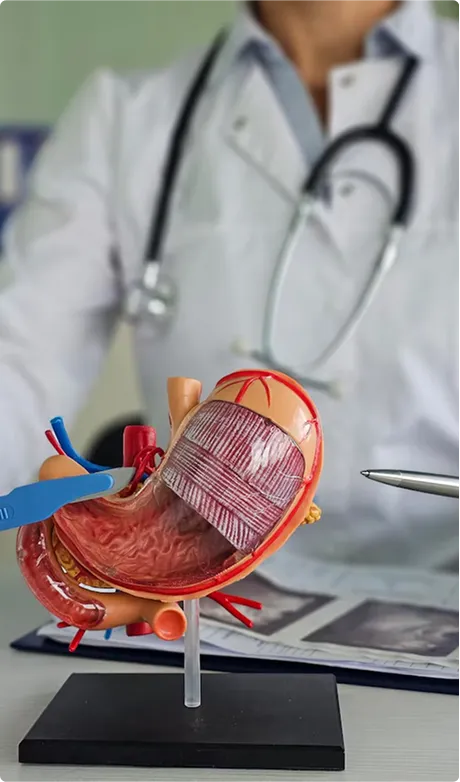Overview
Stomach cancer, also known as gastric cancer, begins in the stomach. While its cases have dropped significantly in the last two decades, it remains one of the most common cancers worldwide. The most frequent type, adenocarcinoma, develops in the stomach’s inner lining. Other types can form in the middle or outer layers, but they are much less common.
Stomach cancer, also known as gastric cancer, begins in the cells lining the stomach. The stomach, located on the left side of the upper abdomen, plays a key role in digesting food. It is part of the digestive tract, a system of connected hollow organs that process nutrients and remove waste from the body:
- Food travels from the throat to the stomach through the esophagus.
- Once in the stomach, muscles mix the food with digestive juices to break it down.
- The partially digested food then moves into the small intestine, followed by the large intestine.
- The rectum, the final section of the large intestine, stores waste until it is expelled through the anus during a bowel movement.
Adenocarcinoma of the stomach starts in the mucus-producing cells of the stomach’s inner lining and accounts for nearly all cases of stomach cancer.
Stomach adenocarcinoma is classified based on its location:
- Gastric cardia cancer: Develops in the top portion of the stomach, just below the esophagus.
- Non-cardia gastric cancer: Occurs in any other part of the stomach.
It is also categorized based on how the cells appear under a microscope:
- Intestinal adenocarcinoma: The cancer cells are well differentiated, resembling normal stomach cells.
- Diffuse adenocarcinoma: The cells are poorly differentiated, appearing different from normal cells. This type tends to grow and spread more aggressively, making it harder to treat.
- Gastric cardia cancer: Gastroesophageal junction adenocarcinoma (GEJ): Forms where the esophagus meets the stomach. Treatment may follow approaches for either stomach or esophageal cancer.
- Gastrointestinal neuroendocrine tumors: Arise from neuroendocrine cells in the digestive tract, which regulate digestive juices and muscle movement in the stomach and intestines.
- Gastrointestinal stromal tumors (GIST): Develop in nerve cells in the stomach wall and other digestive organs. GIST is classified as a soft tissue sarcoma.
- Primary gastric lymphoma: A type of non-Hodgkin lymphoma affecting the stomach, most commonly mucosa-associated lymphoid tissue (MALT) lymphoma or diffuse large B-cell lymphoma.
- Rare stomach cancers: These include squamous cell carcinoma, small cell carcinoma, and leiomyosarcoma, though they are uncommon.
Symptoms
Stomach cancer usually doesn’t cause noticeable symptoms in its early stages. Even common warning signs, such as unexplained weight loss and stomach pain, often don’t appear until the disease has progressed.
Possible Symptoms of Stomach Cancer:
- Loss of appetite
- Trouble swallowing
- Fatigue or weakness
- Nausea and vomiting
- Unexplained weight loss
- Heartburn or indigestion
- Black stools or vomiting blood
- Bloating or gas after eating
- Stomach pain, often above the belly button
- Feeling full after eating only a small amount








